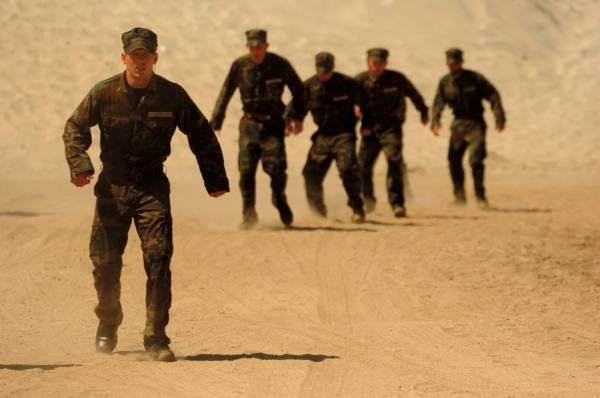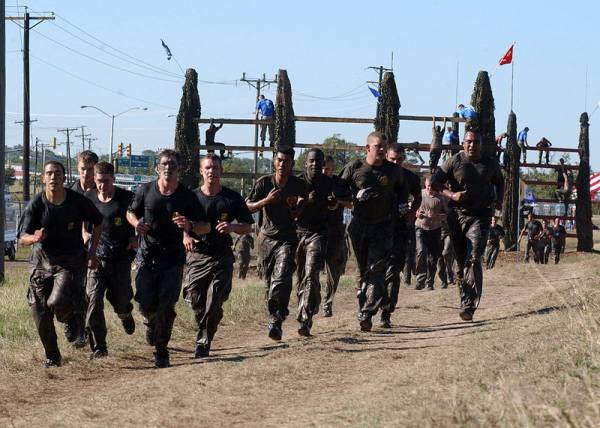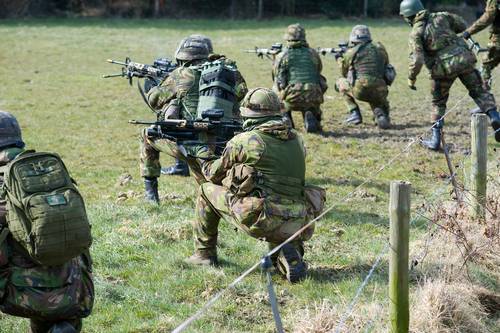The Special Forces workouts start today! This program is designed by Special Forces operator Wes Kennedy. If you are a candidate preparing for the military or a Special Forces selection, this nine-month program will help you achieve your goals.
Click Here to Get Started on the Special Forces Workouts
The Special Forces workouts start today! This program is designed by Special Forces operator Wes Kennedy. If you are a candidate preparing for the military or a Special Forces selection, this nine-month program will help you achieve your goals.
Click Here to Get Started on the Special Forces Workouts
Special Forces Workouts FAQ
Below are some answers to frequently asked questions. This should help you get the most out of the Special Forces workout program.
What does A1/A2, or B1/B2/B3, etc. mean?
When there is a number that follows the letter, it means you must alternate the various exercises. For example, if you were given the movements below:
- A: Power Clean x 3-4; rest 4 min x 4
- B1: Front Squat x6-8; rest 1 min x 3
- B2: Pull Ups x 6-8; rest 1 min x 3
- C1: Back Extension x 10-15; rest 30 sec x 3
- C2: Sit Ups x 10-15; rest 30 sec x 3
- C3: Front Leaning Raise (FLR) 30s ec; rest 30 sec x 3
You would complete 4 sets of 3-4 reps of power cleans while resting 4 min in between sets, THEN complete: (1 set of 6-8 rep front squats, rest 1min, 1 set of 6-8 rep pull ups, rest 1 min) x 3, THEN complete: (a set of back extensions, rest 30 sec, a set of sit ups, rest 30 sec, FLR, rest 30 sec) x 3.
It seems like a lot of rest, and I feel good. Can I reduce the rest time?
No. The rest is there to ensure that you can perform at the pace prescribed. If you feel the rest time is too long, write a post on the blog and I will help you figure out why. The workout might not be intended to be overly hard, you may not be pushing hard enough, or you might not have the strength to perform the movements at the required pace.
What does 3010 mean? What is a tempo set?
These ensure we get the dose response required for the exercise. There are four numbers for every tempo and they correspond to the following:
- 1st number: eccentric
- 2nd number: pause
- 3rd number: concentric
- 4th number: pause
- X = explosive
- A = assisted for the concentric action
So a 32X2 pull up would mean 3 seconds down, 2 seconds at the bottom, as fast as you can up, and 2 seconds held at the top.

What do 80%, 90%, 100% mean?
This is something you will learn over time. Keep in mind that 80/90/100% for sixty seconds is not the same pace as 80/90/100% for sixty minutes. Also keep in mind the rest time. If you are doing 1 min work/6 min rest x 7, your percentage of effort will potentially be more intense than that same percentage of effort for 30 sec work/30 sec rest x 20.
If this does not make sense now, it will eventually. For the first one, the work/rest scheme should tell you that you are working your anaerobic system, and you should judge your percentage of effort accordingly. The second work/rest scheme should tell you that you are training your aerobic system, and again, you should judge your percentage of effort accordingly.
You are gauging your percentage of effort on both the time domain and the energy system. Do not take percentages of 1RMs or times as mathematical equations. It is based upon perceived rate of exertion (PRE). This will be learned over time.
How do I warm up for a metabolic conditioning workout?
This will be learned over time through trial and error, but as a general rule of thumb:
- Run, row, or skip for some minutes
- Work on dynamic range of motion for some minutes (see video below).
- Play around with the specific exercises that you will be doing until you feel light and fast for your first set.
- Learn what works and what doesn’t work for you over time
How do I find my 1RM?
The following are loose guidelines. Find out what works for you.
- Run, row, or skip for 5-10 minutes until you feel the blood flowing, getting some breathing going.
- Do range of motion drills and get everything moving.
- 5 reps @ 50% of possible 1RM at same tempo for the 1RM test; rest as needed x 2-3
- 3 reps @ 75% possible 1RM at same tempo for the 1RM; rest as needed x 1-2
- 1 rep @ 85% of possible 1RM at same tempo for the 1RM; rest as needed x 1
- 1 rep @ 90% of possible 1RM at same tempo for the 1RM; rest as needed.
If you feel good, attempt your 1RM. If you still feel slow and not ready to attempt your max, then build up a few more times before attempting your planned 1RM. Play with it. You need to find out what works for you in terms of how slow or fast you build up, with more or less sets and more or less rest time. If you hit non-technique-based failure twice, then you’re done.
How do I find my 85% AMRAP for pull ups and dips?
85% = ((BW+ 1RM) x 0.85) – BW
For example, if I weighed 200lbs and I put 100lbs on me for a 1RM strict pull up I would add them together to get 300lbs. Multiply that by 0.85 to get 255lbs. I would then subtract my bodyweight from this (255-200) giving me 55lbs. 55 lbs would be the weight I would use for the 85% AMRAP
What is an AMRAP/AMSAP?
AMRAP stands for as many rounds/reps as possible.
AMSAP stands for as many seconds as possible.

What should I make note of for workouts?
- How did you feel going into it?
- Did you sleep okay the night before?
- Are you fueled properly?
- Are you stressed out at home/work?
- How did the workout feel?
- Did you get to where you wanted?
- How was your breathing?
- How was your circulation?
- How were your fear, your mental game, and your brain?
- Was your breathing taxed or was your brain taxed?
- Note the conditions: outdoors, indoors, weather, terrain.
- If you feel it’s relevant to the training program, add it in.
- When in doubt, record as much information as you can.
What weight do I start at for each exercise of the workout?
You should start at a weight that will allow you to incrementally increase the weight every set while reaching failure or near failure on the final set.
For instance, if the workout called for squat @ 3010 x 5-7; rest 2:30 x 5 and your recent 5RM in the squat is 225lbs, then your workout should look something like this: 205(7) 210(6) 215(5) 220(4) 220(5). If you start the workout and it looks like this: 205(6) 210(4) 210(1), stop there. Your body is telling you something and you’re not doing it any good by continuing.
Note: If the top of the rep range is achieved, you must go up in weight each set. If it is not achieved or the bottom or the rep range is not achieved, then you must stay at the same weight.

Repetitions: How should I progress if the workout calls for…?
5-5-5-5-5: Each set has to be hard, increasing in weight every set. You do not need to reach a personal record (PR) on this, but it may happen. You should be lifting near your 5RM weight. If your PR in the deadlift is 315, then you may lift 290(5) 300(5) 305(5) 310(5) 315(5).
5-4-3-2-1: Again, you do not need to try to hit a PR on this, but it may happen. Each set should be hard, increasing in weight every set. If your PR in the deadlift is 360 then it may look like this: 310(5) 320(4) 335(3) 345(2) 355(1)
1RM: Read the question above “How do I find my 1RM?” You are not using tough sets to build up to the 1RM as you would in the previous sets.
First Set: Ensure you are following the tempo prescribed. If not, then the weight is too heavy and you are not getting the response required. You may think this isn’t important, but everything is programmed for a reason. Trust your coach, be a workhorse, and hit it as instructed.
Second Set: Take the prescribed rest time. If you think it is too much rest, tell me on the forum. If you think it is not enough rest, tell me on the forum. There is a method to the madness.
What is Z1?
Z1 is used for blood flow, fat mobilization, and recovery. It is a not a predetermined pace, but varies based on the individual, recovery, environmental factors, and the modality being used. A good rule of thumb is to keep it at 65-75% intensity or heart rate below 135bpm. There is no “trying harder” in these workouts, just relax and get the body moving.
Get Started on the Special Forces Workouts
Photo 1 by Photographer’s Mate 1st Class (AW) Michael W. Pendergrass [Public Domain] via Wikimedia Commons.
Photo 2 by Photographer’s Mate 1st Class (AW) Shane T. McCoy [Public Domain] via Wikimedia Commons.
Photo 3 by By U.S. Navy photo by Chief Photographer’s Mate Eric A. Clement [Public domain], via Wikimedia Commons.
Photo 4 courtesy of Shutterstock.






